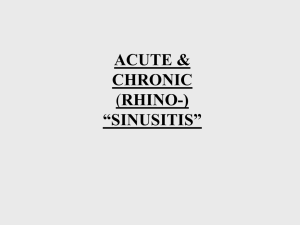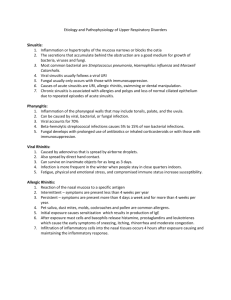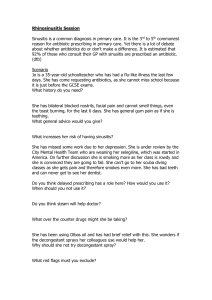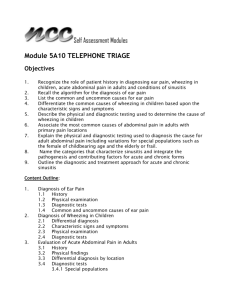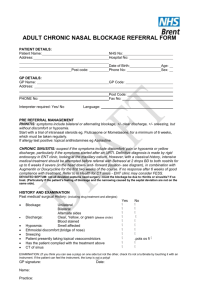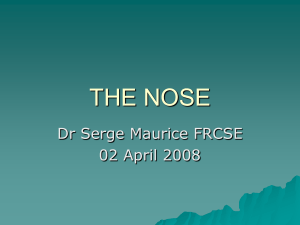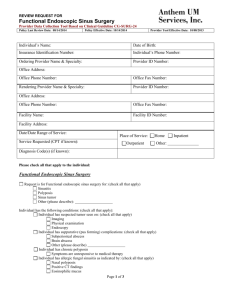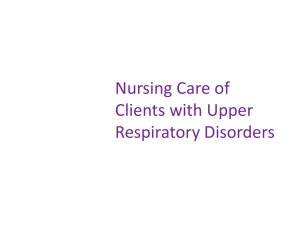We conducted a MEDLINE search of the medical literature for... English-language review articles published between 1990 and 1997 for the
advertisement
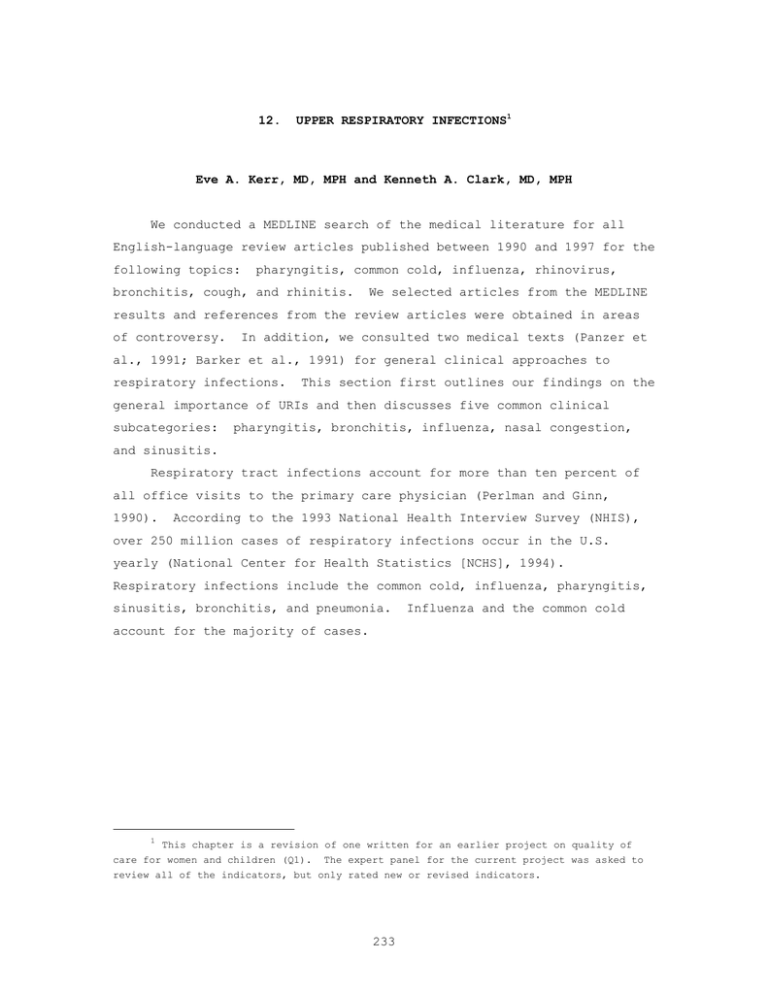
12. UPPER RESPIRATORY INFECTIONS1 Eve A. Kerr, MD, MPH and Kenneth A. Clark, MD, MPH We conducted a MEDLINE search of the medical literature for all English-language review articles published between 1990 and 1997 for the following topics: pharyngitis, common cold, influenza, rhinovirus, bronchitis, cough, and rhinitis. We selected articles from the MEDLINE results and references from the review articles were obtained in areas of controversy. In addition, we consulted two medical texts (Panzer et al., 1991; Barker et al., 1991) for general clinical approaches to respiratory infections. This section first outlines our findings on the general importance of URIs and then discusses five common clinical subcategories: pharyngitis, bronchitis, influenza, nasal congestion, and sinusitis. Respiratory tract infections account for more than ten percent of all office visits to the primary care physician (Perlman and Ginn, 1990). According to the 1993 National Health Interview Survey (NHIS), over 250 million cases of respiratory infections occur in the U.S. yearly (National Center for Health Statistics [NCHS], 1994). Respiratory infections include the common cold, influenza, pharyngitis, sinusitis, bronchitis, and pneumonia. Influenza and the common cold account for the majority of cases. 1 This chapter is a revision of one written for an earlier project on quality of care for women and children (Q1). The expert panel for the current project was asked to review all of the indicators, but only rated new or revised indicators. 233 ACUTE PHARYNGITIS IMPORTANCE According to the National Ambulatory Medical Care Survey: 1991 Summary, acute pharyngitis ranked tenth as a reason for visit in the ambulatory care setting. It accounted for 1.6 percent of all visits. SCREENING There are no current recommendations on screening for acute pharyngitis in asymptomatic patients. DIAGNOSIS Multiple bacterial and viral organisms may cause acute pharyngitis (Barker et al., 1991). In evaluating acute pharyngitis, the critical clinical decision is whether or not to use antibiotics, or to culture, for group A streptococcal infection. Group A streptococcus is the causative agent of rheumatic fever, which can result in serious renal and cardiac disease. The incidence of rheumatic fever is currently low, and has been decreasing independent of antibiotic use (Little and Williamson, 1994). In fact, over 78,000 persons would be required in an RCT to show convincingly a 50 percent reduction in the attack rate of rheumatic fever with antibiotics (Shvartzman, 1994). The benefit of prescribing antibiotics for pharyngitis must be weighed against the costs. Little and Williamson (1994) estimate that if every case of pharyngitis were treated with antibiotics, the average general practitioner in the United Kingdom would have roughly a one in three chance of having a patient die from anaphylaxis after treatment for sore throat. This is slightly higher than the chances of nephritis or rheumatic fever developing post-pharyngitis, neither of which have a high death rate. Komaroff (1986) has helped define pretest probabilities and diagnostic strategies for pharyngitis (Panzer et al., 1991). Based on prospective studies estimating sensitivity and specificity of clinical findings with respect to confirmed diagnosis of Group A streptococcal 234 infection, Komaroff has determined that in adult patients who have a sore throat but do not have a fever, tonsillar exudate, or anterior cervical adenopathy, the probability of streptococcal pharyngitis is less than three percent (Indicator 1). On the other hand, when all three of these findings are present, the probability of streptococcal pharyngitis is at least 40 percent. Diagnostic tests that are useful to determine the presence of group A streptococcus include throat culture and rapid streptococcal antigen tests. Throat cultures are shown to be falsely negative in approximately ten percent of patients (Panzer et al., 1991). Rapid antigen tests are highly specific, but variably sensitive (80 to 95 percent) (Panzer et al., 1991). According to Komaroff (1986) and based on the prospective studies of persons with sore throat, a reasonable diagnostic strategy is as follows: 1. Patients with pharyngitis who have a low probability of streptococcal infection (lack of fever, cervical adenopathy, and tonsillar exudate) do not require a throat culture or treatment with antibiotics. The exceptions to this are: persons with a history of rheumatic fever, documented streptococcal exposure in the past week, and residence in a community in which there is a current streptococcal epidemic. 2. Persons with an intermediate probability of streptococcal infection (presence of one or two of the following: fever, cervical adenopathy, or tonsillar exudate) should receive a throat culture. Whether to treat immediately or await culture results is left to the discretion of the clinician. 3. Persons with a high probability of streptococcal pharyngitis (presence of all three of the following: fever, cervical adenopathy, and tonsillar exudate) should be treated immediately with antibiotics. Throat culture is not required for confirmation (Indicators 2 and 4). 4. In young persons, the diagnosis of mononucleosis, especially for pharyngitis of greater than one week’s duration (Wood et al., 1980) should also be entertained. 235 TREATMENT For documented or presumed group A streptococcus, treatment with penicillin or erythromycin is appropriate. Treatment should be for ten days with penicillin V or erythromycin, or with a single intramuscular injection of 1.2 million units of penicillin B benzathine (Indicator 3) (Perlman and Ginn, 1990; Barker et al., 1991). FOLLOW-UP Follow-up cultures are indicated if there is a history of rheumatic fever in the patient or a household contact (Barker et al., 1991). ACUTE BRONCHITIS IMPORTANCE Acute bronchitis is an inflammatory disorder of the tracheobronchial tree that results in acute cough without signs of pneumonia (Billas, 1990). An estimated 12 million physician visits per year are made for acute bronchitis, with annual costs upward of $300 million for physician visits and prescription costs (Billas, 1990). SCREENING There are no current recommendations on screening for acute bronchitis in asymptomatic patients. DIAGNOSIS The causative organism of acute bronchitis is usually viral, but a variety of bacterial organisms may cause or contribute to bronchitis (e.g., Streptococcus pneumoniae, Mycoplasma pneumoniae, Chlamydia pneumoniae, B. catarrhalis, and Bordetella pertussis) (Billas, 1990; Barker et al., 1991). Cough may be nonproductive initially but generally becomes mucopurulent. less. The duration of cough is two weeks or Sputum characteristics are not helpful in distinguishing etiology of cough (Barker et al., 1991). precede onset of cough. Pharyngitis, fatigue and headache often Examination of the chest is usually normal, but may reveal bronchi or rales without any evidence of consolidation 236 (Indicator 6). A detailed history must be obtained to rule in or out other possible causes for acute cough (Indicator 5). Acute cough is defined as lasting less than three weeks (Pratter et al., 1993). Bronchitis, sinusitis, and the common cold are probably the most common causes of acute cough. Cough secondary to irritants (e.g., tobacco smoke) and allergies (e.g., from allergic rhinitis) are the next most common causes of cough (Zervanos and Shute, 1994). Smokers with acute bronchitis should be encouraged to stop smoking, at least for the duration of the acute illness (Indicator 7) (Barker et al., 1991). TREATMENT Most authorities agree that treatment with antibiotics in patients who are otherwise healthy and free of systemic symptoms is not useful (Barker et al., 1991; Billas, 1990). Orr et al.,(1993) conducted a review of all randomized placebo-controlled trials of antibiotics for acute bronchitis published in the English language between 1980 and 1992. Four studies showed no significant benefit of using antibiotics, while two studies (one using erythromycin and the other using trimethoprim sulfa) did show benefit in decrease of subjective symptoms. FOLLOW-UP There are no clear indications for routine follow-up of acute bronchitis. INFLUENZA IMPORTANCE Data from the 1993 NHIS indicated that there were approximately 133 million episodes of influenza-like illness annually in the United States, with an attack rate of 52.2 episodes per 100 persons per year (Benson and Marano, 1994). Most influenza symptoms are cause by influenza A virus, which is dispersed by sneezing, coughing, or talking. While generally a self-limited disease, pandemics of influenza have caused heavy death tolls (Wiselka, 1994). 237 Influenza causes between 10,000 and 20,000 deaths in the United States annually, especially among the elderly and those with chronic medical conditions (Fiebach and Beckett, 1994). In addition, influenza can cause complications such as pneumonitis, secondary pneumonia, Reye's syndrome, myositis and myoglobinuria, myocarditis, and neurologic sequelae (Wiselka, 1994; Barker et al., 1991). SCREENING There are no current recommendations on screening for influenza in asymptomatic patients. DIAGNOSIS Uncomplicated influenza has an abrupt onset of systemic symptoms including fever, chills, headache and myalgias. The fever generally persists three to four days, but may persist up to seven days. Respiratory symptoms (e.g., cough, hoarseness, nasal discharge, pharyngitis) begin when systemic symptoms begin to resolve. Physical findings include toxic appearance, cervical lymphadenopathy, hot skin, watery eyes and, rarely, localized chest findings (e.g., rales). TREATMENT Treatment for uncomplicated influenza is generally symptomatic, with rest, fluid intake, and aspirin or acetaminophen. Dyspnea, hemoptysis, wheezing, purulent sputum, fever persisting more than seven days, severe muscle pain, and dark urine, may indicate onset of influenza complications (Barker et al., 1991). Amantadine has been shown to decrease virus shedding and shorten duration of influenza symptoms if treatment was started within 48 hours of symptom onset. Common side-effects include headache, light headedness, dizziness and insomnia. Amantadine should be considered for use in patients at high risk who develop symptoms of a flu-like illness during an influenza outbreak (Delker et al., 1980).2 According to a 1979 National Institutes of Health (NIH) consensus development conference, adults who should be Rimantadine is also an appropriate form of treatment. 2 238 considered for prophylaxis include those with chronic diseases, those whose activities are vital to community function and who have not been vaccinated, and persons in semi-closed institutional environments (NIH, 1979). However, because decisions about amantadine use are often subjective, amantadine use will not be employed as a quality indicator. FOLLOW-UP There are no clear indications for routine follow-up of influenza. NASAL CONGESTION AND RHINORRHEA IMPORTANCE Nasal congestion was the principal reason for over eight million patient visits across all age groups in the United States in 1989 (NCHS, 1992). Nasal congestion may be due to a variety of causes, the principal of these being acute viral infection (i.e., common cold), allergic rhinitis and infectious sinusitis (acute or chronic) (Canadian Rhinitis Symposium, 1994). Other common causes include vasomotor rhinitis and rhinitis medicamentosa. Appropriate treatment rests in making distinctions among these causes. Other less common reasons for rhinitis include atrophic rhinitis and hormonal rhinitis and mechanical/obstructive rhinitis. The Canadian Rhinitis Symposium convened in January of 1994 to develop a guide for assessing and treating rhinitis (Canadian Rhinitis Symposium, 1994). The guidebook is extensive, but essential elements for diagnosis and treatment are discussed below. SCREENING There are no current recommendations on screening for nasal congestion and rhinorrhea in asymptomatic patients. DIAGNOSIS AND TREATMENT The following descriptions may serve to differentiate between allergic rhinitis, infectious viral rhinitis (common cold), and sinusitis: 239 Allergic Rhinitis Symptoms: Nasal congestion, sneezing, palatal itching, rhinorrhea with or without allergic conjunctivitis. Symptoms are seasonal or perennial and may be triggered by allergens such as pollens, mites, molds, and animal dander. Physical exam: nasal mucosa is pale or hyperemic; edema with or without watery secretions are frequently present. Treatment: Treatment of allergic rhinitis should include antihistamines, nasal cromolyn and/or nasal glucocorticoid sprays. decongestants may be used for symptomatic relief. Oral If prescribed, topical nasal decongestants are indicated for short term use only (Indicator 8). Infectious Viral Rhinitis Symptoms: Nasal congestion and rhinorrhea. Other symptoms of viral infectious rhinitis include mild malaise, sneezing, scratchy throat, and variable loss of taste and smell. Colds due to rhinoviruses typically last one week, and rarely as long as two weeks (Barker et al., 1991). Symptoms are generally of acute onset, unless chronic sinusitis is present (see below - chronic sinusitis). Symptoms of coexisting acute sinusitis may also be present (see Acute Sinusitis below). Physical exam: Mucosa hyperemic and edematous with or without purulent secretions; physical exam should include nasal cavity and sinuses (for presence of sinusitis) and ears (for presence of otitis media) (Barker et al., 1991). Treatment: Sinus tenderness and fever may be present with sinusitis symptomatic. Treatment of infectious viral rhinitis without sinusitis is Use of oral decongestants or short term nasal decongestants is appropriate but not necessary. For coexisting sinusitis, treatment should be with antibiotics in addition to decongestants (see acute sinusitis below)(Indicator 9). Sinusitis Symptoms/Physical Exam/Treatment: See discussions below on acute and chronic sinusitis. 240 FOLLOW-UP There are no clear indications for routine follow-up of nasal congestion or rhinorrhea. ACUTE SINUSITIS IMPORTANCE According to the 1991 National Ambulatory Medical Care Survey, sinusitis was the eighth most common diagnosis rendered by physicians for office visits in 1991. This translates into 1.7 percent of all visits among children and adults. Patients frequently mentioned symptoms which could be attributable to sinusitis--headache in 1.5 percent of visits and nasal congestion in 1.3 percent of visits. In adults 25 to 44 years of age, sinusitis accounted for 2.3 percent of visits and allergic rhinitis for 2.3 percent. SCREENING There are no current recommendations on screening for sinusitis in asymptomatic patients. DIAGNOSIS Acute sinusitis is defined as a sinus infection that lasts less than three weeks (Stafford, 1992). Acute sinusitis is a complication in about 0.5 percent of viral upper respiratory tract infections (Barker, 1991). Symptoms that may increase the likelihood of acute sinusitis being present include fever, malaise, cough, nasal congestion, toothache, purulent nasal discharge, little improvement with nasal decongestants, and headache or facial pain exacerbated by bending forward (Williams and Simel, 1993). Transillumination may improve the accuracy of diagnosis for maxillary sinusitis, but its usefulness is operator sensitive (Williams and Simel, 1993). TREATMENT Treatment is based on controlling infection and reducing tissue edema. Ten to fourteen days of antibiotics should be instituted for 241 treatment of acute sinusitis, although there is some recent evidence that three days may suffice (Williams et al., 1995; Balfour and Benfield, 1996; and Gehanno and Berche, 1996). Some have even recently questioned the utility of antibiotic therapy in acute sinusitis (van Buchem, 1997). For these reasons, our indicators do not specify a minimum time period for antibiotic treatment of acute sinusitis. In addition to antibiotics, oral or topical decongestants should be used. If a topical nasal decongestant is given, treatment should be limited to no more than four days (Barker et al., 1991; Stafford, 1992) (Indicator 8). Antihistamines, because of their drying action on the nasal mucosa, have no role in the treatment of most patients with acute sinusitis, except when patients also manifest symptoms of allergic rhinitis (thin, watery rhinorrhea, and sneezing) (Stafford, 1992). FOLLOW-UP If symptoms fail to improve after seven days, a ten to fourteen day course of therapy with another antibiotic should be prescribed (Stafford, 1992). If symptoms persist after two courses of antibiotics, referral to an otolaryngologist and/or more definitive diagnostic studies (e.g., x-ray, sinus CT, nasal endoscopy) are indicated (Indicator 10)(Stafford, 1992). CHRONIC SINUSITIS IMPORTANCE The discussion for acute sinusitis also applies to chronic sinusitis. SCREENING There are no current recommendations on screening for acute sinusitis in asymptomatic patients. DIAGNOSIS Sinusitis that has continued for three months or more is considered chronic (Stafford, 1992). Chronic sinusitis appears to result from 242 episodes of prolonged, repeated, or inadequately treated acute sinusitis. Chronic sinusitis generally presents with dull ache or pressure across the midface, which patients characterize as a headache. The headache may be worse in the morning and with head movement. In addition, patients may also complain of nasal congestion and thick pharyngeal secretions, blocked or popping ears, dental pain, chronic cough, mild facial swelling, and eye pain (Godley, 1992). Conditions that commonly predispose to chronic sinusitis include previous acute sinusitis, allergic rhinitis, environmental irritants, nasal polyposis, and viral infection (Godley, 1992). Diagnosis rests on history, evaluation by nasal endoscopy, and CT scanning (Bolger and Kennedy, 1992). In general, if the history is strongly suggestive of chronic sinusitis, one should treat first with antibiotics (see below). If medical therapy is unsuccessful or if the disease recurs repeatedly, referral to an otolaryngologist for endoscopic examination is indicated (Bolger and Kennedy, 1992). Endoscopic examination is more specific for chronic sinusitis than is CT scanning. If endoscopic findings are equivocal, a CT scan may demonstrate underlying sinus disease. However, a CT is best performed four to six weeks after optimal medical therapy is instituted to optimize specificity (Bolger and Kennedy, 1992). TREATMENT Medical treatment should be attempted first. First-line therapy for chronic disease is amoxicillin and clavulonic acid (Augmentin), three times daily for 21 to 28 days (Bolger and Kennedy, 1992), or trimethoprim-sulfamethoxazole, cefaclor, cefuroxime, and cefixime (Godley, 1992) (Indicator 11). Other medications that may be used include oral decongestants, nasal steroids, and antihistamines for patients with an allergic component. If a topical nasal decongestant is prescribed, treatment should be limited to no more than four days (Indicator 8)(Barker et al., 1991; Stafford, 1992). If medical therapy is unsuccessful or if the disease recurs without immunological cause, referral to an otolaryngologist is indicated (Indicator 12)(Bolger and Kennedy, 1992). 243 FOLLOW-UP When medical therapy fails surgical treatment may be considered. Currently, endoscopic surgery is the method of choice (Bolger and Kennedy, 1992). Endoscopic examination and debridement of the operative cavity are required once or twice weekly for four to six weeks to promote healing and prevent stenosis of the sinus ostia. Complications of surgery include CSF rhinorrhea, diplopia, blindness and meningitis. However, the rates of complications are very low among experienced surgeons. In studies reporting success rates of surgery in consecutive patients, up to 93 percent of patients reported substantial symptomatic improvement in a two-year follow-up, and subsequent revision surgery is reported in seven to ten percent (Bolger and Kennedy, 1992). It should be noted that no randomized controlled trials or case-controlled studies for endoscopic surgery have been performed. 244 REFERENCES Barker LR, JR Burton, and PD Zieve, Editors. 1991. Principles of Ambulatory Medicine, Third ed.Baltimore, MD: Williams and Wilkins. Benson V and Marano MA. 1994. Current estimates from the National Health Interview Survey, 1993. National Center for Health Statistics. Vital Health Statistics 10(190). Billas A. December 1990. Lower respiratory tract infections. Primary Care 17 (4): 811-24. Bolger WE, and DW Kennedy. 30 September 1992. Changing concepts in chronic sinusitis. Hospital Practice 27 (9A): 20-2, 26-8. Canadian Rhinitis Symposium. 1994. Assessing and treating rhinitis: A practical guide for Canadian physicians. Proceedings of the Canadian Rhinitis Symposium; Toronto, Ontario; January 14-15, 1994. Canadian Medical Journal 15 (Suppl. 4): 1-27. Centers for Disease Control. 27 May 1994. Prevention and control of influenza: Part I, vaccines. Morbidity and Mortality Weekly Report 43 (RR-9): 1-13. Delker LL, L Moser, H Robert et al. 1980. Amantadine: Does it have a role in prevention and treatment of influenza? Annals of Internal Medicine 92 (Part 1): 256-8. Fiebach N, and W Beckett. 28 November 1994. Prevention of respiratory infections in adults: Influenza and pneumococcal vaccines. Archives of Internal Medicine 154: 2545-57. Garibaldi RA. 28 June 1985. Epidemiology of community-acquired respiratory tract infections in adults: Incidence, etiology, and impact. American Journal of Medicine 78 (Suppl. 6B): 32-7. Godley FA. May 1992. Chronic Sinusitis: Physician 45 (5): 2190-9. An Update. American Family Komaroff A, TM Pass, MD Aronson et al.,January 1986. The prediction of streptococcal pharyngitis in adults. Journal of General Internal Medicine 1: 1-7. Little PS, and I Williamson. 15 October 1994. Are antibiotics appropriate for sore throats? British Medical Journal 309: 101011. National Center for Health Statistics. December 1994. Current estimates from the National Health Interview Survey, 1993. U.S. Department of Health and Human Services, Hyattsville, MD. 245 National Center for Health Statistics. April 1992. National Ambulatory Medical Care Survey: 1989 summary. U.S. Department of Health and Human Services, Hyattsville, MD. National Center for Health Statistics. 1994. National Ambulatory Medical Care Survey: 1991 summary. U.S. Department of Health and Human Services, Hyattsville, MD. National Center for Health Statistics. February 1993. Prevalence of selected chronic conditions: United States, 1986-88. U.S. Department of Health and Human Services, Hyattsville, MD. National Institutes of Health Consensus Development Conference Summaries. Amantadine: Does it have a role in the prevention and treatment of influenza?, 51-6. Sponsored by the National Institute of Allergy and Infectious Diseases, October 15-16, 1979. Orr PH, K Scherer, A Macdonald et al., 1993. Randomized placebocontrolled trials of antibiotics for acute bronchitis: A critical review of the literature. Journal of Family Practice 36 (5): 50712. Panzer RJ, ER Black, and PF Griner, Editors. 1991. Diagnostic Strategies for Common Medical Problems.Philadelphia, PA: American College of Physicians. Perlman PE, and DR Ginn. January 1990. Respiratory infections in ambulatory adults: Choosing the best treatment. Postgraduate Medicine 87 (1): 175-84. Pratter MR, T Bartter, S Akers et al., 15 November 1993. An algorithmic approach to chronic cough. Annals of Internal Medicine 119 (10): 977-83. Shvartzman P. 15 October 1994. Careful prescribing is beneficial. British Medical Journal 309: 1011-12. Stafford CT. November 1990. The clinician's view of sinusitis. Otolaryngology-Head and Neck Surgery 103 (Volume 5, Part 2): 8705. Williams JW, DR Holleman Jr., GP Samsa et al.,5 April 1995. Randomized controlled trial of 3 vs 10 days of trimethoprim/sulfamethoxazole for acute maxillary sinusitis. Journal of the American Medical Association 273 (13): 1015-21. Williams JW, and DL Simel. 8 September 1993. Does this patient have sinusitis? Diagnosing acute sinusitis by history and physical examination. Journal of the American Medical Association 270 (10): 1242-6. 246 Wiselka M. 21 May 1994. Influenza: Diagnosis, management, and prophylaxis. British Medical Journal 308: 1341-5. Wood RW, RK Tompkins, and BW Wolcott. November 1980. An efficient strategy for managing acute respiratory illness in adults. Annals of Internal Medicine 93 (5): 757-63. Zervanos NJ, and KM Shute. March 1994. Acute, disruptive cough: Symptomatic therapy for a nagging problem. Postgraduate Medicine 95 (4): 153-68. 247 RECOMMENDED QUALITY INDICATORS FOR UPPER RESPIRATORY INFECTIONS These indicators apply to men and women age 18 and older. These indicators were endorsed by a prior panel and reviewed but not rated by the current panel. Pharyngitis Indicator Diagnosis 1. For patient who present with a complaint of sore throat, a history/physical exam should document presence or absence of: a. fever; b. tonsillar exudate, and c. anterior cervical adenopathy. Treatment 2. Patients with sore throat and fever, tonsillar exudate and anterior cervical adenopathy should receive immediate treatment for presumed streptococcal infection. 3. Treatment of streptococcal throat infection should be with penicillin V, amoxicillin, or erythromycin for 10 days; or with a single injection of benzathine penicillin. 4. If an antibiotic is NOT prescribed with the diagnosis of sore throat, a throat culture or rapid antigen test should be obtained if any of the following are present: a. fever; b. tonsillar exudate, and c. anterior cervical adenopathy. Quality of Evidence Literature Benefits Comments II Komaroff, 1986 Alleviate sore throat. Prevent rheumatic heart disease. Prevent rheumatic fever. If all three are present, the probability of streptococcal infections is greater than 40% and one would be inclined to treat empirically without culture. II Komaroff, 1986; Panzer, 1991 Decrease sore throat. Prevent rheumatic fever. III Barker et al., 1991 Decrease sore throat. Prevent rheumatic fever. Since throat cultures and rapid antigen tests vary in their sensitivity and specificity, this combination of symptoms is sufficient to warrant antibiotic treatment without further laboratory testing. This is the current standard of care, although other antibiotics (e.g., ampicillin) are also effective. II Komaroff, 1986 Prevent rheumatic fever. Each finding increases the probability of streptococcal infection. 248 Bronchitis, Acute Indicator Diagnosis 5. The history of patients presenting with cough of less than 3 weeks’ duration should document presence or absence of fever and shortness of breath (dyspnea). 6. Patients presenting with acute cough should receive a physical examination of the chest for evidence of pneumonia. Treatment 7. If the history documents cigarette smoking in a patient with acute cough, encouragement to stop smoking should be documented. Quality of Evidence Literature Benefits III Barker et al., 1991 These symptoms are consistent with possible pneumonia, which would require antibiotic treatment. III Barker et al., 1991 Decrease cough. Decrease shortness of breath. Prevent development of emphysema. Prevent development of sepsis. Decrease cough. Decrease shortness of breath. Prevent development of emphysema. Prevent development of sepsis. III Barker et al., 1991 Prevent future bronchitic episodes. Prevent smokingrelated morbidity and mortality. Smokers are predisposed to bronchitis. Symptomatic patients present a window of opportunity to counsel regarding smoking cessation. Quality of Evidence Literature Benefits Comments Signs of consolidation would lead one on a different diagnostic and treatment path. Nasal Congestion Indicator Treatment 8. If topical nasal decongestants are prescribed, duration of treatment should be for no longer than 4 days. 9. Patients with nasal congestion and/or cough without a concurrent diagnosis of sinusitis, bronchitis, or pneumonia should not be prescribed antibiotics. III III Stafford et al., 1992; Barker et al., 1991 Stafford et al., 1992; Barker et al., 1991 249 Prevent rhinitis medicamentosa. May prevent emergence of antibiotic-resistant bacteria. Comments Long-term treatment with topical decongestants can cause rebound congestion (rhinitis medicamentosa). Expert panelists felt that antibiotics should not be prescribed without documentation of need, due to the increase in antibiotic-resistant bacteria. Acute Sinusitis Indicator Treatment 10. If a patient with acute sinusitis does not improve after two courses of antibiotics, referral to an otolaryngologist or for a diagnostic test (CT, x-ray, ultrasound of the sinuses) is indicated. Quality of Evidence III Literature Stafford et al., 1992 Benefits Decrease nasal congestion. Prevent development of chronic sinusitis. Comments Reevaluation of diagnosis and/or surgical treatment may be indicated. Chronic Sinusitis Indicator Treatment 11. If a diagnosis of chronic sinusitis is made, the patient should be treated with at least 3 weeks of antibiotics. 12. If patient with chronic sinusitis has repeated symptoms after 2 separate 3 week trials of antibiotics, a referral to an otolaryngologist or for a diagnostic test (CT, x-ray, ultrasound of the sinuses) is indicated. Quality of Evidence Literature III Stafford et al., 1992 III Bolger and Kennedy, 1992 Benefits Decrease nasal congestion and other symptoms of chronic sinusitis.1 Prevent recurrence of sinusitis. Decrease nasal congestion and other symptoms of 1 chronic sinusitis. Prevent recurrence of sinusitis. Comments It is generally agreed that a longer duration of treatment for chronic sinusitis is necessary than for acute sinusitis. However, the exact number of days has not been defined in RCTs. The literature cites 3 weeks as the standard of care. While medical treatment is still first-line therapy, surgical treatment may be indicated if two course of antibiotics fail to relieve symptoms. Definitions and Examples 1 Symptoms of chronic sinusitis include nasal congestions, fever, headache, facial pain, toothache, rhinorrhea, and purulent nasal discharge. Quality of Evidence Codes I II-1 II-2 II-3 III RCT Nonrandomized controlled trials Cohort or case analysis Multiple time series Opinions or descriptive studies 250
